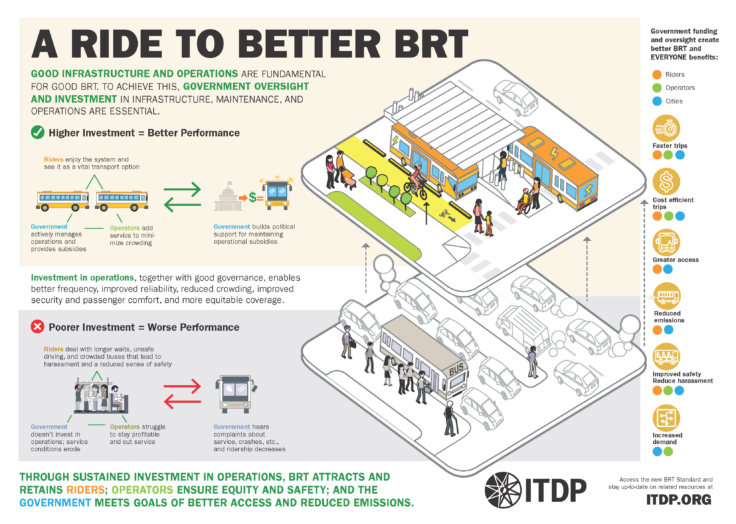June 12, 2024
Putting ITDP’s BRT Climate Impact Calculator Into Practice
In the state of Yucatan in Mexico, a new electric bus rapid transit (BRT) system is providing high-quality, sustainable public transport to the city of Mérida and its population of nearly 900,000 people.
Read more about why this is ITDP’s #YearoftheBus.
This BRT features an all-electric fleet of vehicles – the first entirely electric BRT in the south of Mexico. The team at ITDP Mexico are working with Yucatan’s Transport Agency to plan a new sixth line of the Mérida system called IE-Tram. But, while doing so, they must answer a key question: where and how can Line 6 be built to reach the greatest number of riders while also reducing the greatest amount of transport-related emissions?
To address this question, the team used a new ITDP tool that is now publicly available: the BRT Simple Calculator of Project Effects (SCOPE). This user-friendly Excel spreadsheet tool helps predict the climate and air quality impacts of adding or upgrading a BRT corridor, providing key evidence for planners and decision-makers looking to make the case for investing in more BRT. The SCOPE tool is an update to ITDP’s BRT module of TEEMP (Transport Emissions Evaluation Models for Projects), first released in 2012. The updated BRT SCOPE tool improves on the TEEMP tool with a simpler interface, new default data sources, fewer data requirements for users, and new ways of calculating future ridership.

All of these improvements build on the updates in the 2024 edition of The BRT Standard in order to help users obtain high-level estimates of system impacts without the time and cost requirements of more complicated models. Existing research in the transport sector shows that BRT can be a powerful solution for moving people around cities more comfortably, efficiently, and sustainably than private vehicles. Bus rapid transit infrastructure is often faster and cheaper to build than comparable transit systems (like metro rail), but it can still help cities achieve high-quality service and ridership affordably and efficiently.
For example, Peshawar, Pakistan’s BRT system, Zu Peshawar, moves almost 300,000 people per day with hybrid-electric buses and has received a gold standard BRT ranking for its focus on gender equity, sustainability, and accessibility. In Indonesia, the TransJakarta BRT is the world’s most extensive system of its kind and reaches nearly 82% of the Jakarta metropolitan region with integrated feeder buses as well as BRT. Transjakarta is also aiming to be fully electric by 2030 while its ridership climbs; the system recorded more than one million daily passengers several times in the past year. Such growing interest and potential for BRT in many cities has led ITDP to our year of the bus as we continue providing tools, content, and resources like the SCOPE to empower more transport planners and decision-makers.
Of course, it is important to recognize that not all BRT systems are the same. The BRT SCOPE tool shows how better BRT design can contribute to higher ridership and reduce more emissions. ITDP’s data analysis of BRT corridors around the world revealed four variables that are highly correlated with the ridership of a BRT corridor: the frequency (the number of buses per hour), the number of people near the corridor’s stations (people near transit, or PNT), the current non-BRT bus ridership, and the BRT score. The SCOPE tool uses these variables to provide two different options for predicting future ridership based on the kind of data available to the user. The higher the frequency, PNT, current ridership, and BRT score are, the higher the ridership of the future corridor.
A preview of the SCOPE tool in Excel form. Access it here.

In Mérida, for example, ITDP Mexico used the SCOPE tool three times for assessing three possible IE-Tram corridors. In one case, they planned a 13-kilometer corridor, while in another they planned a longer 15-kilometer corridor. These two additional kilometers were predicted to reach almost 21,000 more people, raising the ridership of that corridor. That means that more people in total would have the option of shifting their travel from emissions-heavy private vehicles to public transport. The SCOPE tool therefore predicts that the longer 15-kilometer corridor can save about 3,000 more tonnes of greenhouse gas emissions and 600 more kilograms of PM2.5 emissions annually. In other words, this is equivalent to taking 1,000 more cars off the road in the city over the course of a year.
Based on this initial estimate, ITDP Mexico can make a compelling case for the longer corridor without hiring external consultants to evaluate multiple time-consuming scenarios. This is just one example of how low-cost, low-data, publicly accessible tools like SCOPE can help transport project planners make the case for funding and building comprehensive bus and BRT systems in their cities. While the BRT SCOPE tool is not meant to be a total replacement for more complex emissions models, it can still provide high-level results that help open the door for research and investment into BRT as a critical access, climate, and air quality solution in cities.

